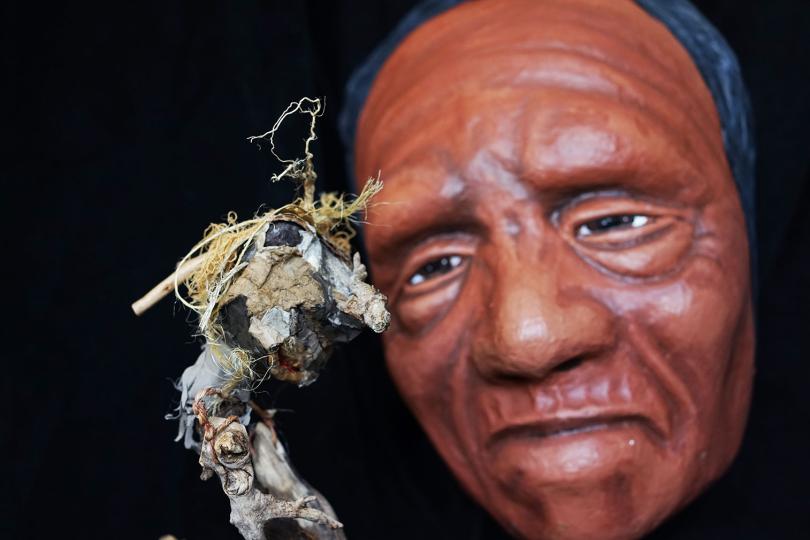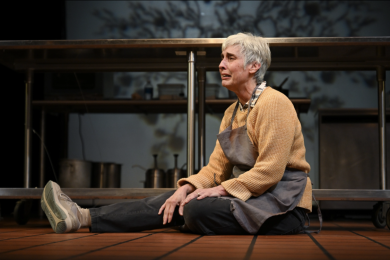Can these puppets lead us to a better world?

This has been yet another week of horrifying national news. Yet again, police guns have been turned against innocent Black men. Tulsa is reeling, and Charlotte is up in arms. But in the midst of the public outcry, family members are also processing their personal grief, and after the rioting dies down, that burden remains.
Queen, now at In the Heart of the Beast, is a poetic rumination on those community members who have perhaps carried that burden the longest – the grandmothers. Co-playwright Junauda Petrus has been thinking about Black grandmothers since at least 2015, when she published the poem, “Could we please give the police departments to the grandmothers?” In both the poem and the play, it is the grandmothers that love fiercely, that fight for their communities, and that bear witness to generations of grief and oppression.
In Queen, the elderly protagonist (in the form of a puppet) voyages through the stages of grief, a dreamscape including a skeletal dog and a live embodiment of the constellation Ursa Major, the Great Bear. Her travels are also narrated by a real-life older Black woman, Laurie Carlos, whose readings are particularly strong when she shows the different sides of the grandmother’s strength – both her wild, rebellious strength, and also the strength that is built over mourning.
Words and music
There are two stand-out highlights of the show, the first of which is the writing by Petrus and co-playwright Erik Ehn. (The author of several plays about genocide, Ehn is well-versed in the challenges of writing about witnessing and experiencing trauma.) Director Alison Heimstead helpfully includes several excerpts from the script in the program, and as I watched, I wondered if the play might be equally – if not more – effective on paper. The language is beautiful, and as much as the puppetry is skillfully done, I sometimes wanted to close my eyes and focus only on the words.
The other clear highlight is the music, performed by Mari Fitch, Selah Obinrin, Matt Larson and Taylor Johnson. Like the poetry, their soulful vocals could easily stand alone. In the context of the play, they serve as emotional punctuation as well as a cultural backdrop – their songs borrow from styles of music that this Black grandmother would plausibly lean on for comfort and familiarity as she goes about her day.
Fragments that work, and some that don't
Although the play is full of strong and affecting elements, the narration, music, and puppetry don’t always come together cleanly. Some of these challenges are mechanical and may get worked out throughout the play’s run. For instance, there are times when words get lost, either because Carlos’s voice isn’t carrying clearly, or because Petrus, who also operates the grandmother puppet, is directing her voice more towards the puppet than towards the audience. I hope these kinks get worked out, since each one of these words deserves to be heard.
In the Heart of the Beast is known for its puppetry, and as a whole, it does not disappoint. The performers make effective use of simple objects to create full landscapes – a tree branch becomes the grandmother’s path, or a sheet of newspaper is fluidly transformed into a flying insect. They excel at depictions of the natural world, and it was particularly fun to see performers mimic the physicality of a bear or an elderly woman while wearing large puppet heads. (This also provides a welcome break from focusing on the normal-sized puppets, which seem quite small unless you sit very close to the front.)
But on a structural level, Queen seemed to struggle to integrate the puppetry smoothly into the text. I would expect a poetic depiction of the grieving process to have some fragmentary moments – since grief itself can leave a person feeling fragmented – but there are a number of instances where the script and puppetry feel disjointed in an unintentional way. A scene where the grandmother puppet is physically tortured is the most striking of those moments, but the presence of the skeleton dog was equally confusing. Each of these choices could have been more affecting if they had felt better supported by the text; as it was, the production sometimes felt like an attempt to layer the staging over the poetry, rather than building a cohesive artistic vision.
Queen feels like an important piece for the attention that it gives to an often under-recognized and under-appreciated figure. Its strong, image-rich poetry and music pay tribute to the grandmothers who nurture, love, and bear witness to their communities’ suffering. But as much as I wanted to fully embrace the experience, the production was uneven. While the grandmother’s travels are at times deeply moving, they sometimes get lost in a sea of metaphors and abstract symbolism. Even so, I cannot help but recommend the play for all that it does well and all that it tries to do – and maybe even for its inscrutability as well. If it helps, you could read it as a mirror for the impenetrability of grief.




